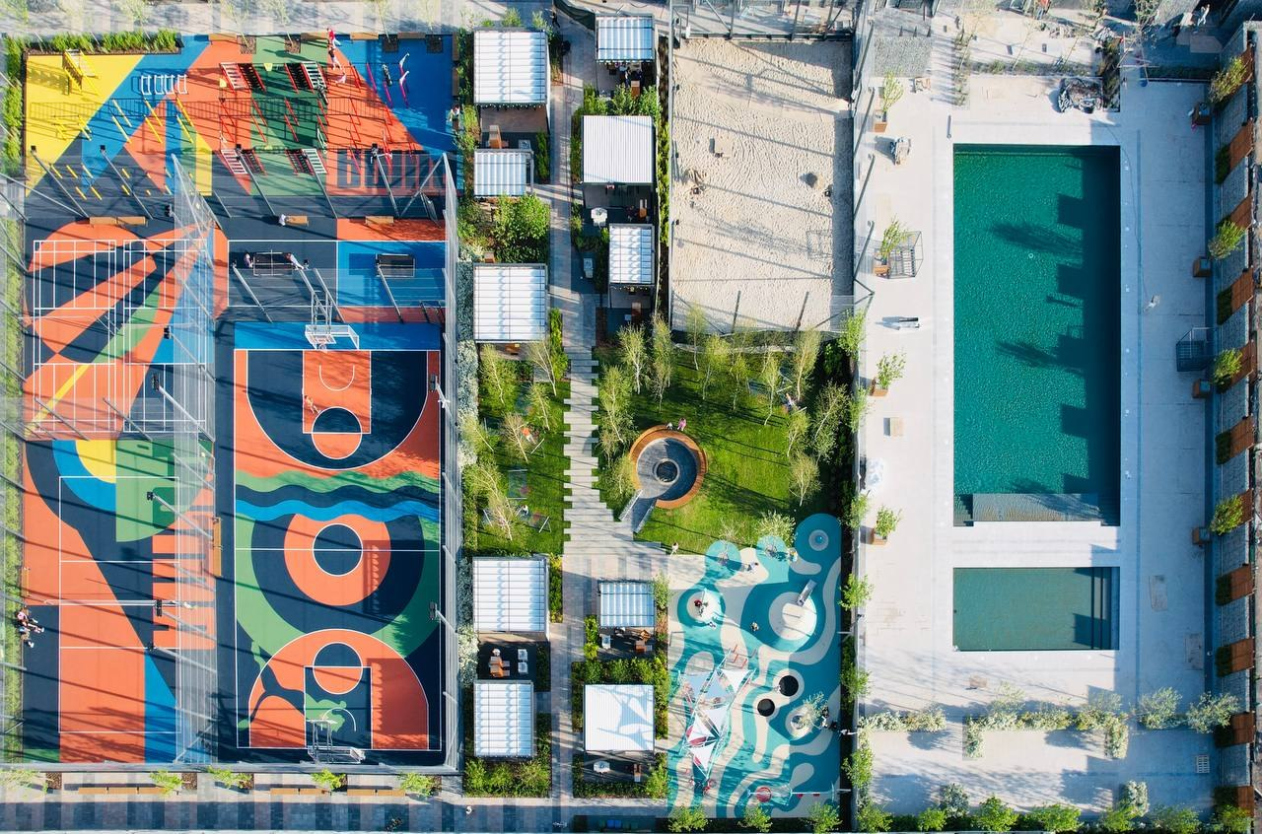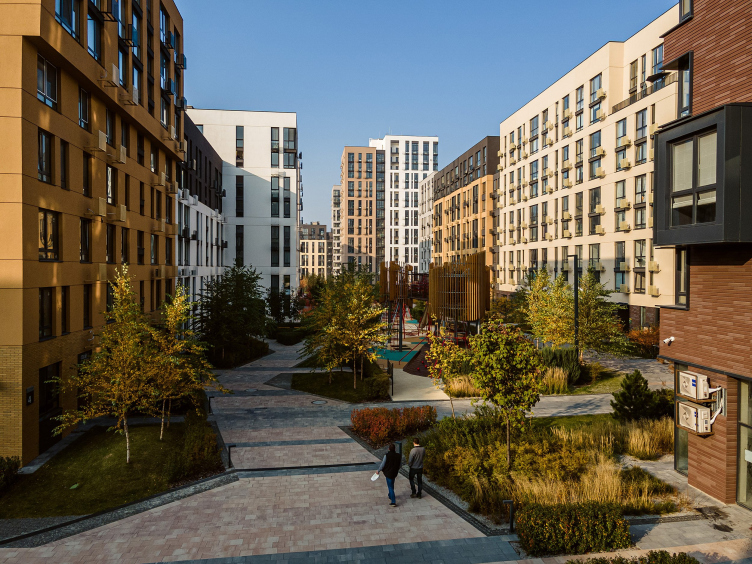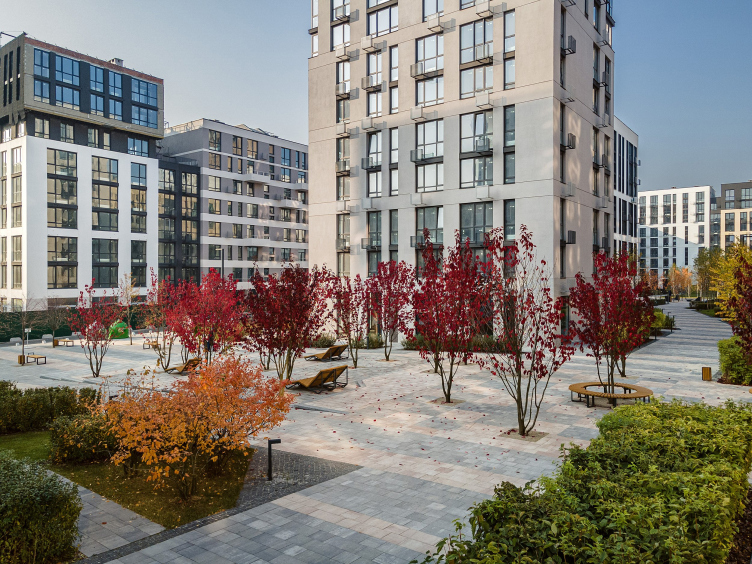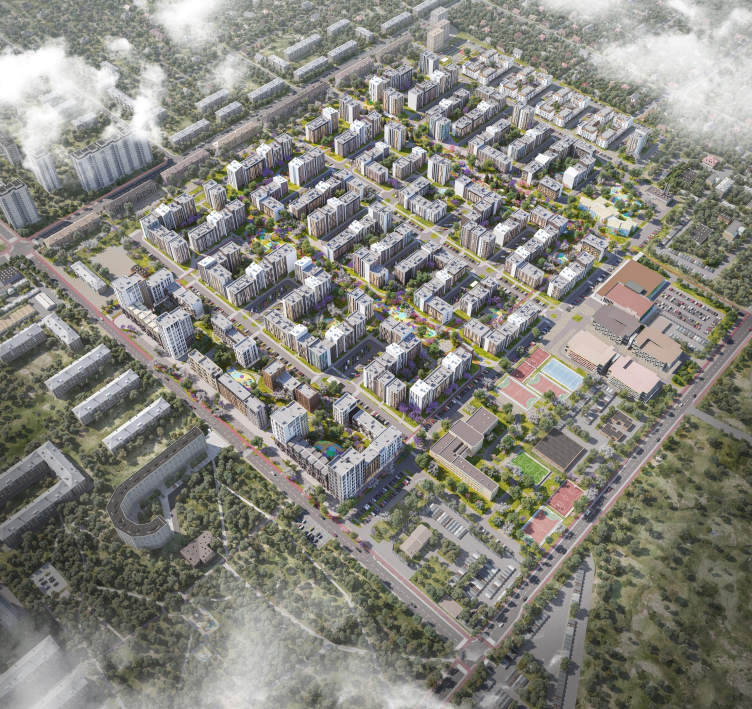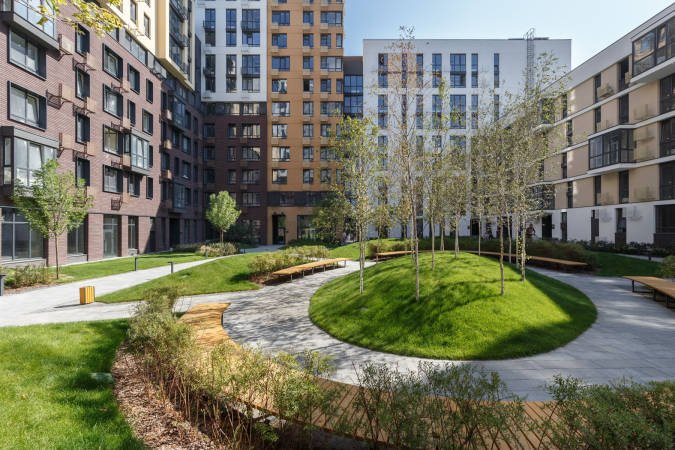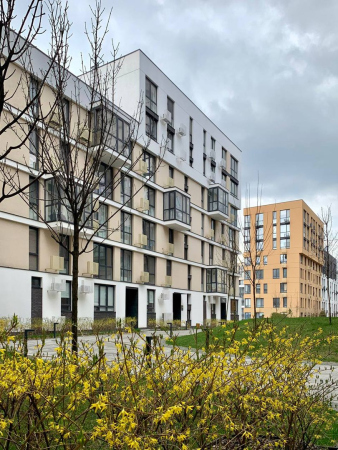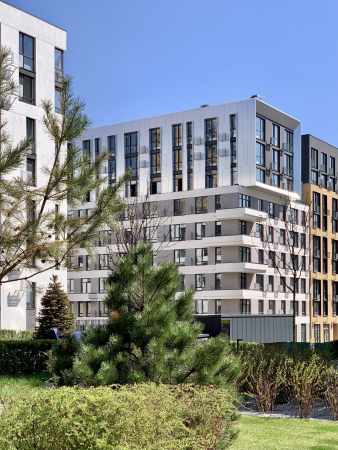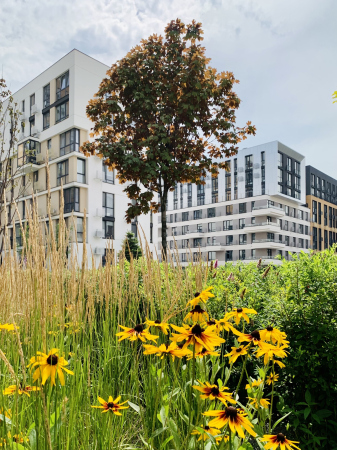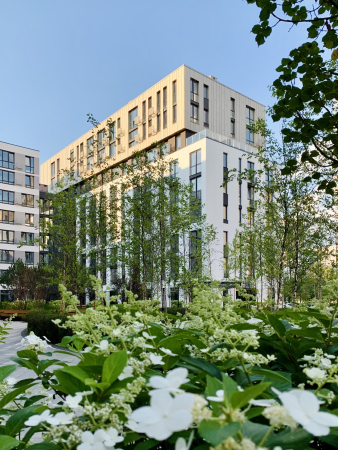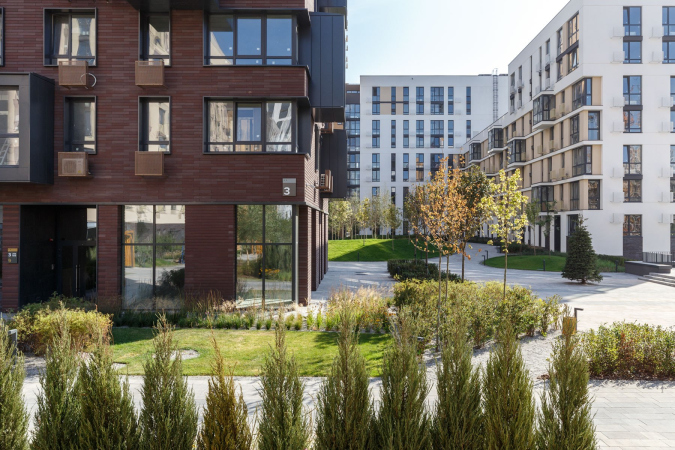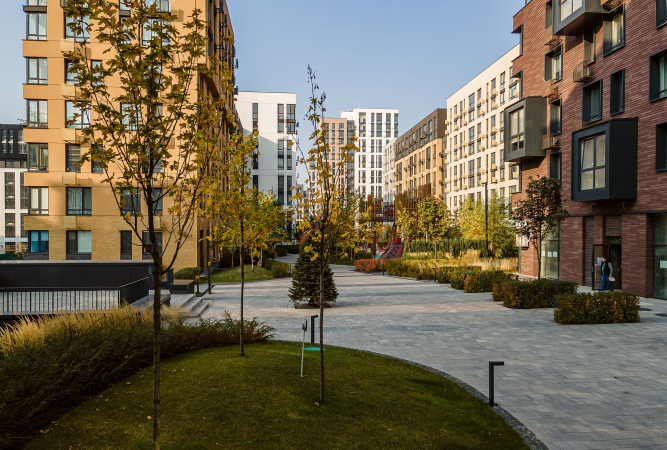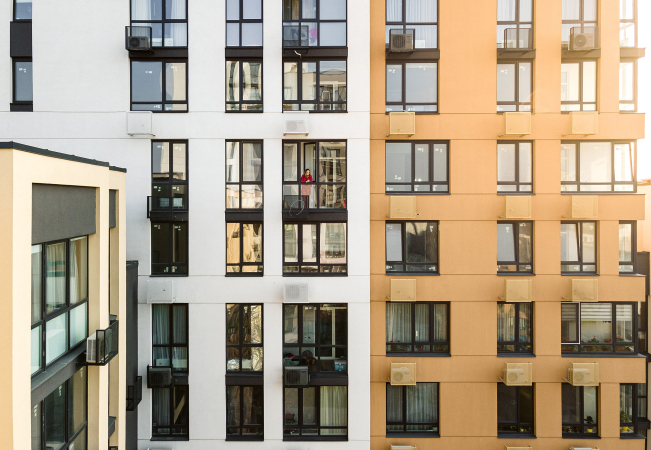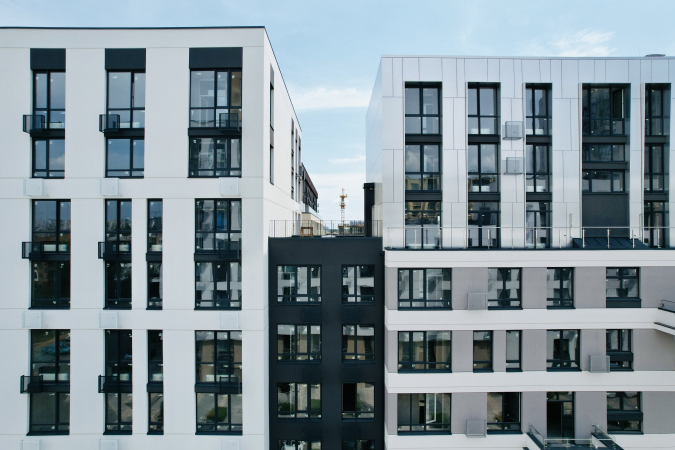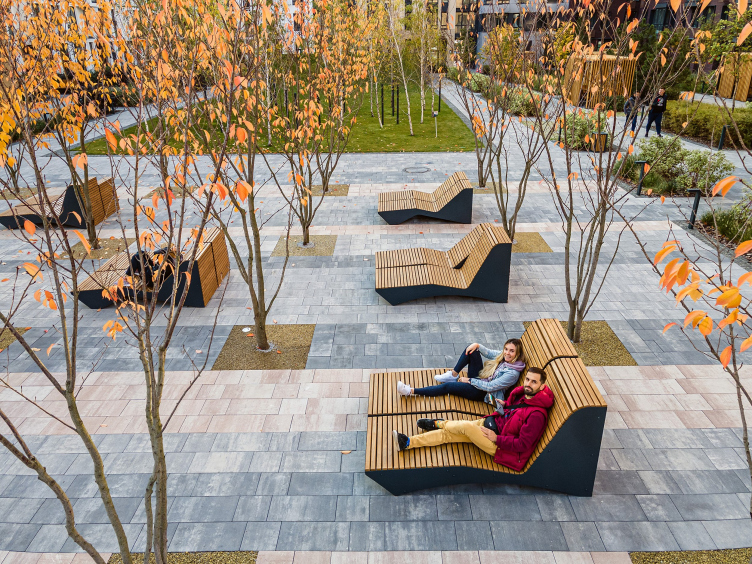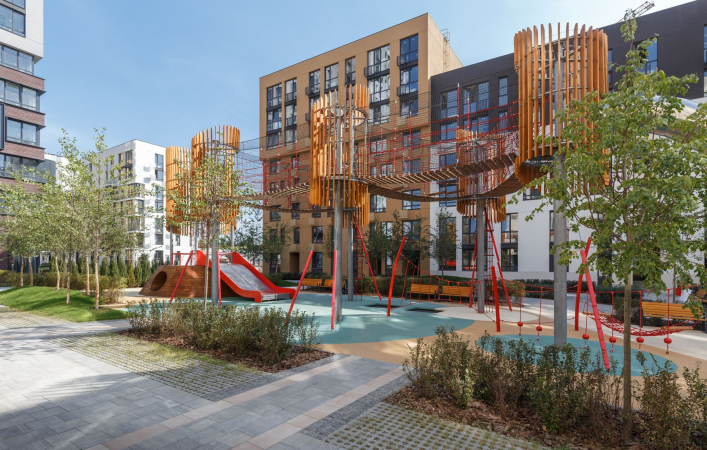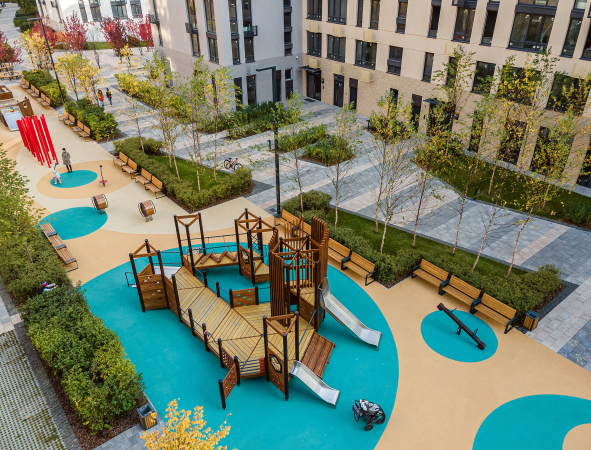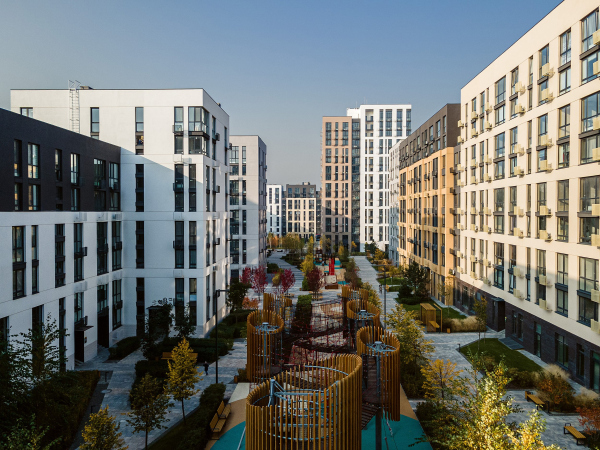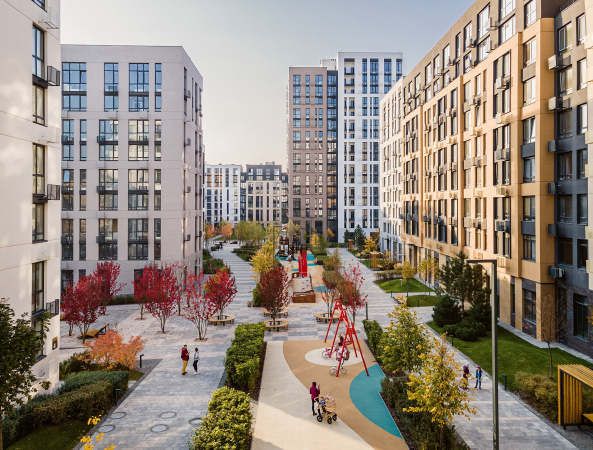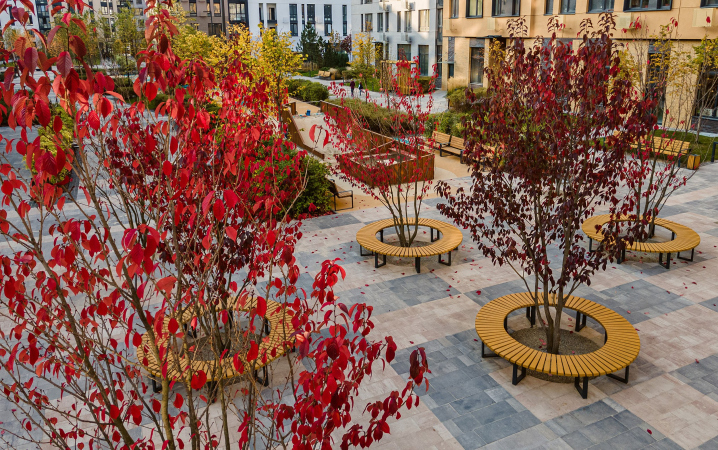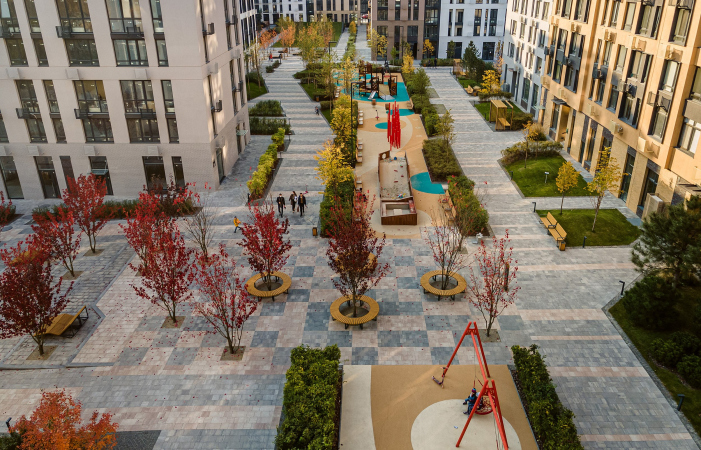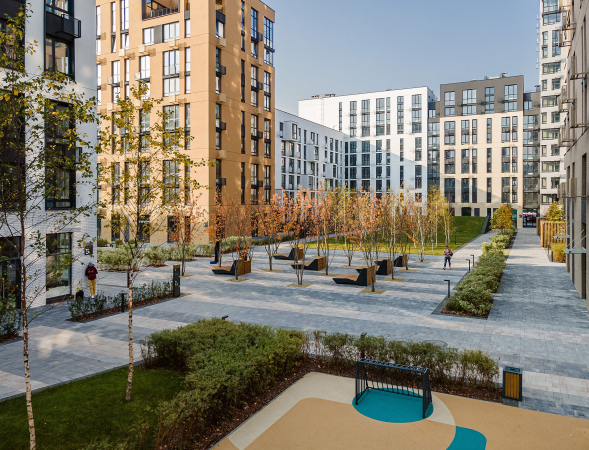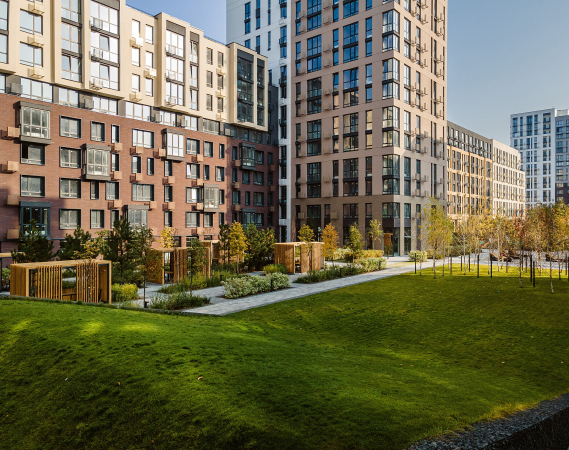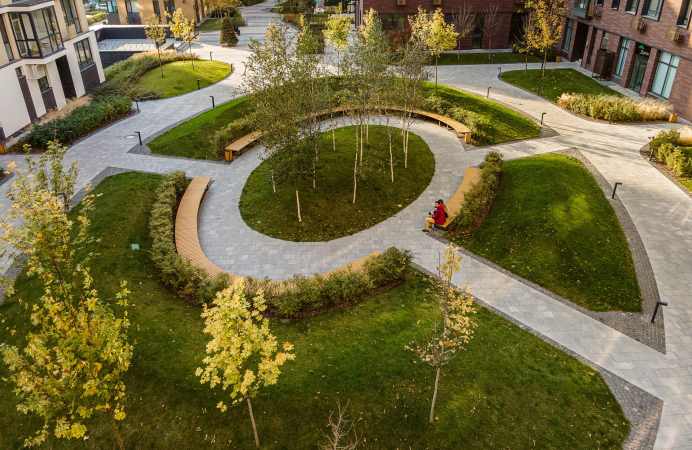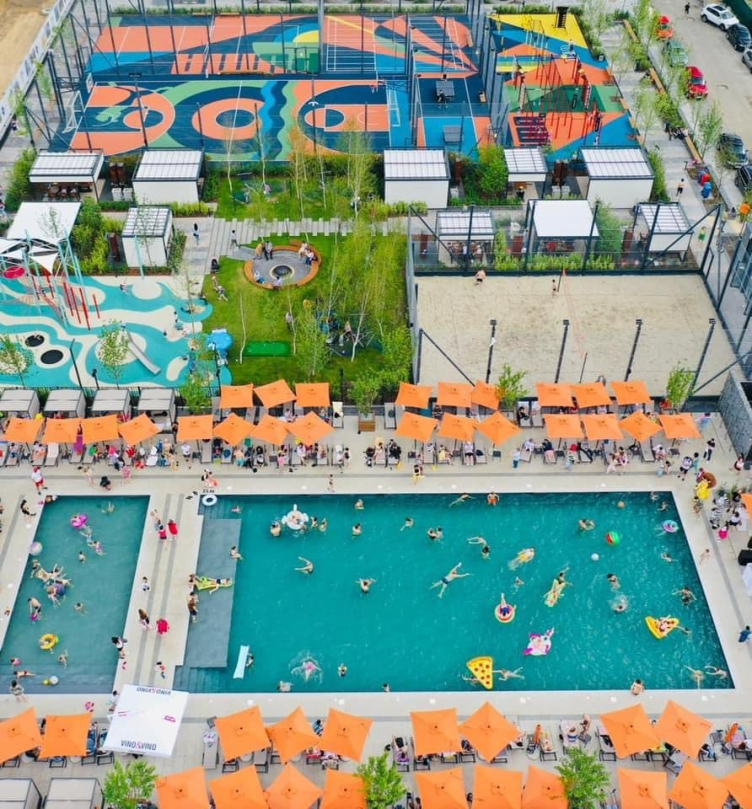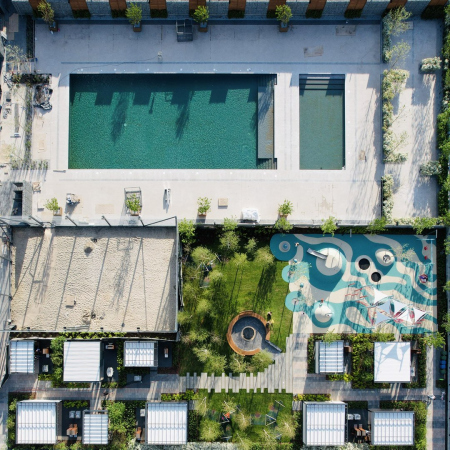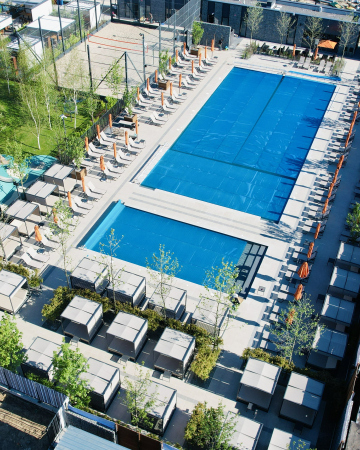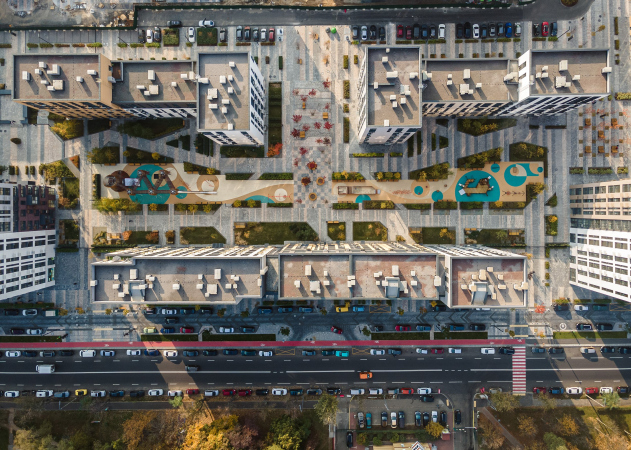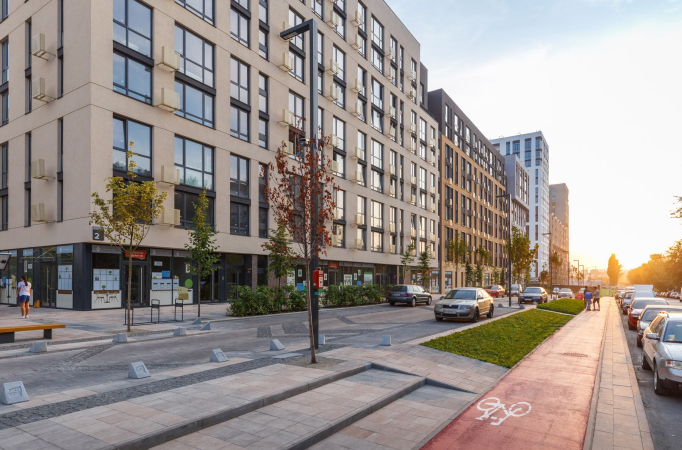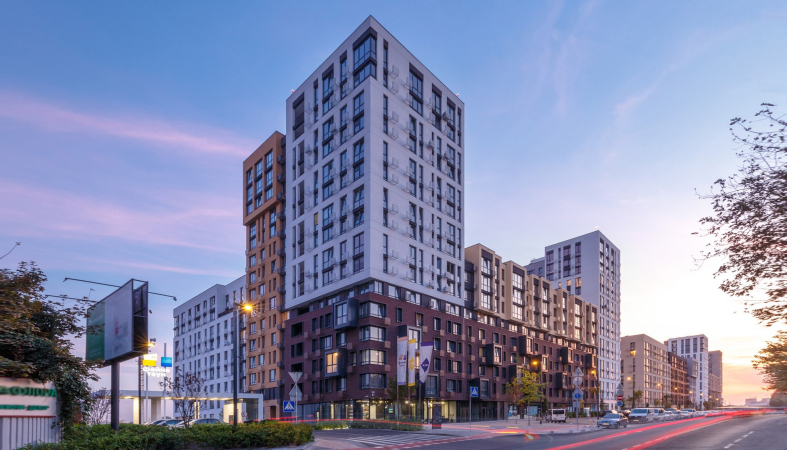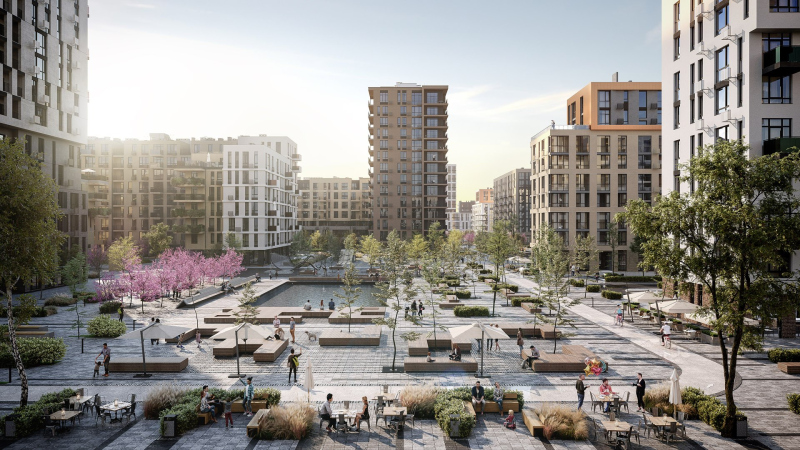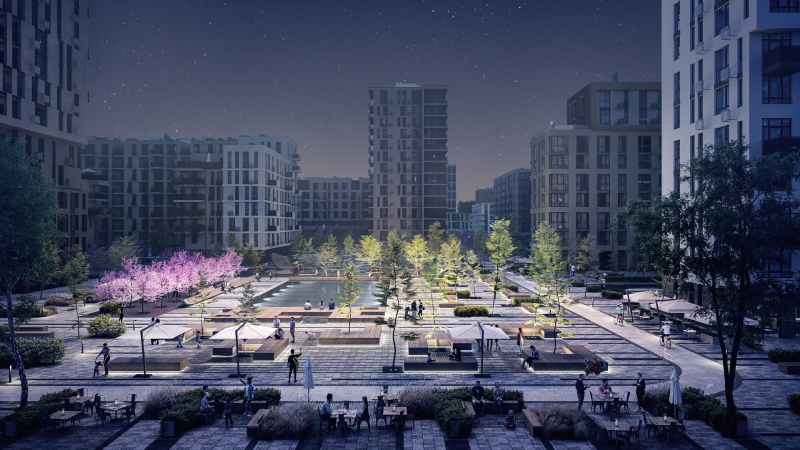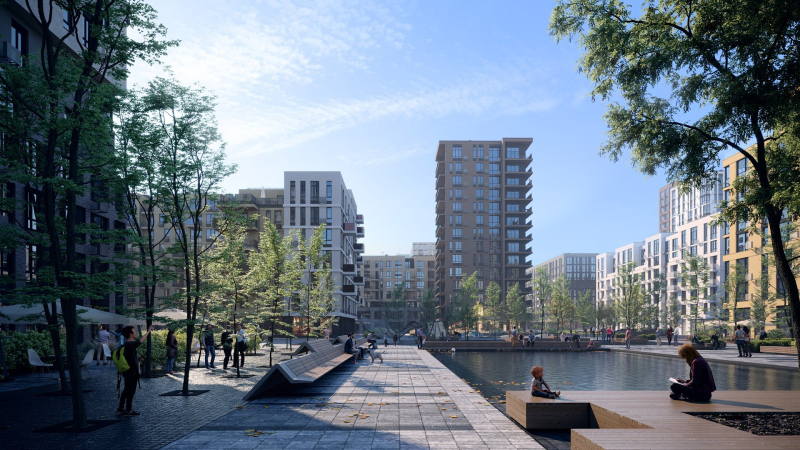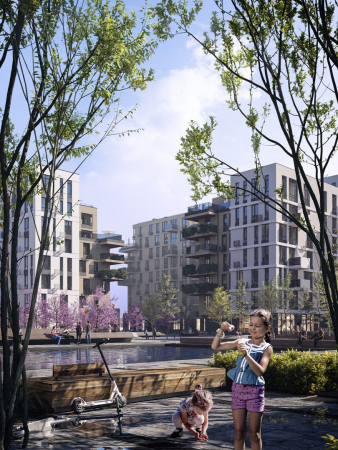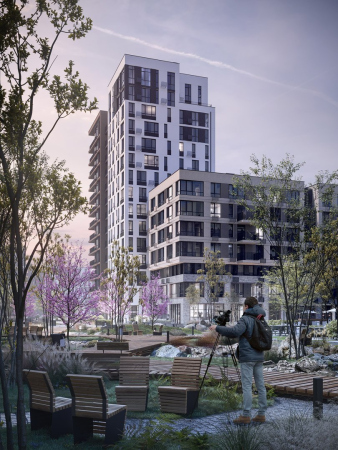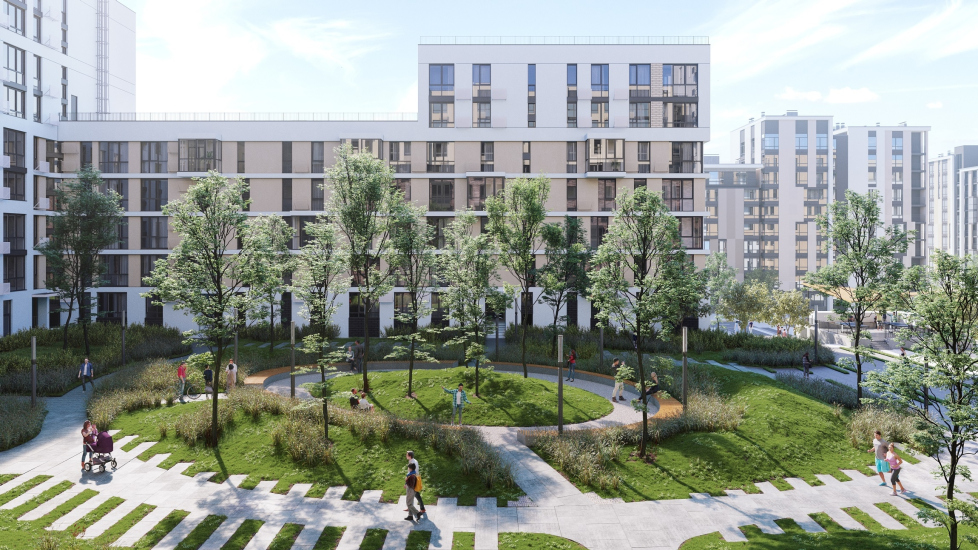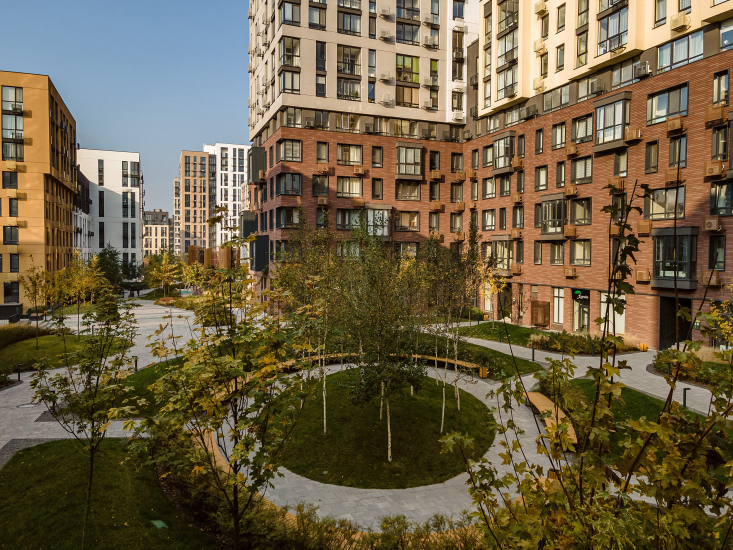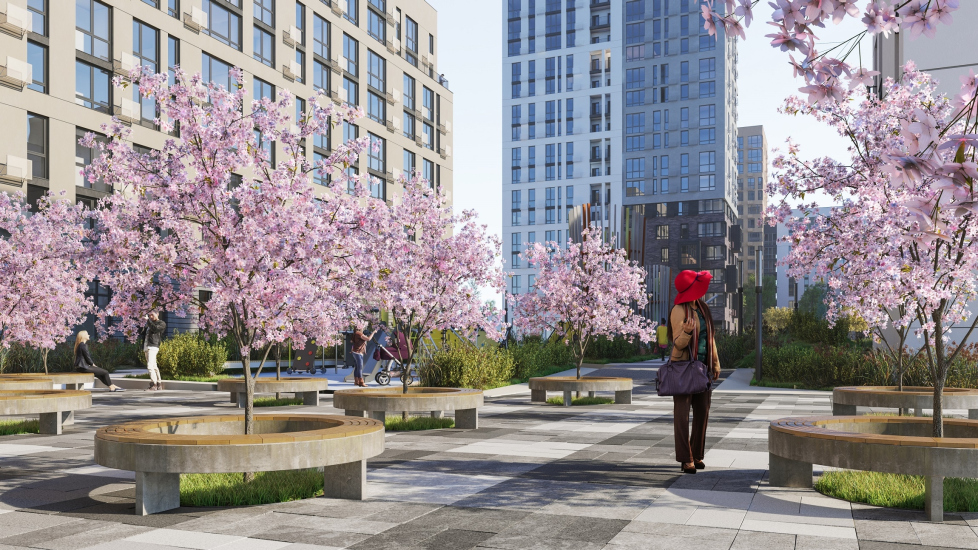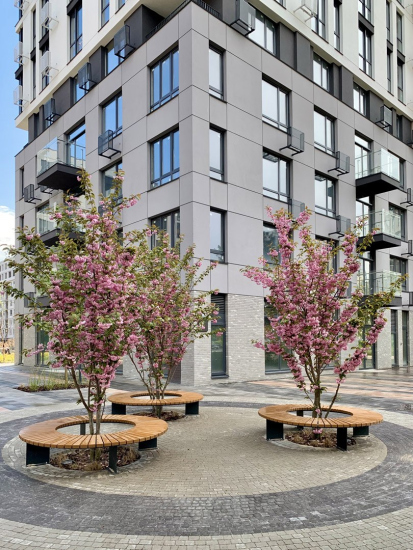Fayna Town complex, Stages 1-2, 2020
Copyright: Photograph © Taras Bespaly / provided by Archimatika
Archimatika is a company that is characterized by a value-centric approach and an ability to make the most of the available data: the projects here are created based on the natural needs of people, which are thoroughly researched, then clearly formulated, and then converted into individual floor plans, eventful streets, and memorable facades. For its housing projects, the company specially developed the PRO-standard – essentially, a recipe for a comfortable environment, which speaks for itself better than any advertising brochure. “Fayna Town” is exactly the case when all the ingredients for the complex recipe are there, and not a single “cooking stage” has been missed.
Fayna Town complex, Stages 1-2, 2020
Copyright: Photograph © Taras Bespaly / provided by Archimatika
This year, the fourth stage of the complex will be completed. The houses will be built together with infrastructure so as to make sure that people would not be living “on the construction site”, and could enjoy the promised benefits, so you can get an impression of the whole by studying one of its parts, which we are going to do now.
Fayna Town complex, Stages 1-2, 2020
Copyright: Photograph © Taras Bespaly / provided by Archimatika
The meanders of the city blocks
The construction of Fayna Town began in 2017 in Kiev’s district of Nivki, which was developed the most intensively in the 1950s and 60s – not really the city center but not a suburb either. The land site, demarcated by the Salutnaya, Akademika Tupoleva, Estonskaya, and Shcherbakovskogo streets, used to be occupied by greenhouses, expo pavilions, and a few small enterprises. The architects also discovered here an alley of half-a-century-old fir trees – it was preserved and included in the future promenade. Generally speaking, the architects received a convenient and extended rectangular site, not burdened by any historical context or any substantial limitations. The latter is perhaps the vicinity of the Antonov airplane repair plant – regular flights do not take place here, but the number of floors of the houses located on the glide path of the runway still had to be significantly reduced.
Totally, the complex will consist of 90 houses – they will form “snakes” of semi-open city blocks from 6 to 16 stories high. Between the “snakes”, there is a system of spaces of various degrees of privacy – from the “Smart Street” open to the city to residents-only inner promenades with a few types of quiet little yards. A significant part of the infrastructure – the swimming pools, the barbecue spot, and sports facilities – is situated on the side of the airfield; the school, the kindergarten, the shopping mall, and the multilevel parking lots are also situated here. Underground parking garages are also being constructed, but not underneath every unit.
“Fayna Town” housing complex
Copyright: © Archimatika
Houses with names
No two houses in Fayna Town are exactly alike, and, hence, all the blocks are also different. Each house is fractured into sections by using color, materials, patterns, windows, balconies, or plastique. This is how an even greater diversity is achieved, as well as an impression of human-friendly scale and parceled construction. As a result, navigation is simplified – it is easy to find not just your building, but even your own window; a sense of belonging is enhanced: the architects strive for such a degree of individuality that each house can receive a nickname from the residents – for example, “copperhead” or “green one”, etc. The differences in height within each block allow you not only to give a proper amount of ambient light to the apartments and reveal wide views from the windows, but also to get as many corner apartments as possible – the “coolest” ones, as Dmitry Vasiliev defines them.
At the same time, “motley” would be the last word to describe this place – all the houses are brought to the same “laconic” common denominator, but, on the other hand, not a single one of them is “rank-and-file” or even neutral – Archimatika does surprise you with the abundance of variations arising within one theme.
The bottom floors, which people perceive on a level of their eyes, are clad in more tactile and finer materials – porcelain stoneware or Klinker brick. The higher up, the brighter and larger the forms become. Interestingly, the developer invited a separate team to work with each type of cladding material, each team specializing in their particular area of expertise.
The complex “map” of the facades adequately reflects the diversity of the floor plans – there are about 800 of them; 100% is made in accordance with the PRO-standard, which means making the most of each square meter and custom-designed floor plans fitting the way of life of different families: some apartments have a large dining room, in some the kitchens are really small, some have large walk-in closets, some have master bedrooms or large working areas. The architects believe that each apartment will ultimately find its owner who will not think of moving walls or coming up with unconventional ways of using corners.
It is expected that the architecture of the next stages will repeat the overall composition of the complex, but new solutions that will respond to the challenges of times will also be possible: for example, right now the architects are including the trend for open-air balconies and terraces of increased square footage into the project.
The main interesting feature of “Fayna Town” is probably that the facades, despite the fact that they are thoroughly thought-out and well-designed, do not catch your eye at once. What does catch your eye is the environment, still quite unusual by the standards of our realities, the kind that we usually describe as “European” or even localize the description to “Finnish”. 13 hectares out of the 40 that the complex consists of will be given to landscaping, more of which below.
The ties of the streets
Before launching this grand-scale project, KAN Development conducted a fair bit of research, the results of which showed that one of the unsatisfied needs of the megalopolis residents is communication. A significant part of the solutions of land improvement in Fayna Town is aimed at helping people meet more often, make new acquaintances, and spend more time usefully: together with their family or simply outdoors in general, being amongst people.
Fayna Town complex, Stages 1-2, 2020
Copyright: Photograph © Taras Bespaly / provided by Archimatika
The central blocks are “belted” by a circular promenade more than 3 kilometers long, which sometimes gets narrower and sometimes wider, and, meeting streets with traffic, rises in a flyover – this is a totally vehicle-free space, where you can walk, cycle, and do full-fledged sports. The promenade helps to gather all the recreational areas between the houses into a single system, turning them into a park spread over the entire complex, which literally lures you to venture outdoors. Just like the houses, no two playgrounds or sports facilities are exactly alike – there is a rope park in one part of the complex, trampolines in another, so that every day you have a choice and a new walking route.
The architects gave as much attention to the neutral and transient zones. There are no “accidental” benches in Fayna Town – each one is placed based upon the view that it commands, each one is accompanied by a hedgerow, which gives you a feeling of protection, and you can always find a place in the shade. In the pedestrian barrier-free zones, there is no asphalt at all – instead, there are more than ten paving patterns, which allow to visually expand a narrow street, divide a square into sections, or just give some extra dynamics to surrounding space. The full-size bushes and trees, geo-plastique, perennial plants, backlighting, and minor architectural forms, just like carefully selected details of the interior, make the space feel cozy and domesticated.
Improvement with an asterisk
After the fourth stage of Fayna Town was opened, its photos began to look like seaside resort ones – people sunbathing on sun loungers, playing beach volleyball and meeting at barbecues. And, while vehicle-free yards can already be considered a norm, a swimming pool still feels like something from another life: the only analogue that comes to mind is Almetyevsk, but in that city the swimming pool caters for the entire city, and here it does for the complex.
Fayna Town complex, Stages 3-4, 2021
Copyright: Photograph courtesy by KAN Development
There are in fact two swimming pools – a 25-meter-long with a shallow end and a bar, and a safe children’s one. 150 sun loungers, bungalows, storage rooms and locker rooms make going for a swim a simple and enjoyable thing to do, which does not require any complex serious efforts in gathering, planning and other logistics. During the cold season, the pool is preserved.
The picnic area, although it does not look as impressive as the swimming pool, is also capable of turning your tedious days into a holiday. The area includes zones for companies of different sizes – you can make a party for two, or invite your friends and have a grand old party; there is also a circular big lawn with a fireplace in the middle. The residents of Fine Town call this place their “summer kitchen” – there is no oven yet, but you can come and cook dinner. A playground is carefully arranged nearby – while the parents are having their boring conversations, the children are also having a good time.
The flashy sports area includes a tennis court, and volleyball, basketball, and football fields.
A little later near this cluster they will build a school for the A+ gymnasium, in which the architectural, design, and construction studies will be curated by the experts from KAN Development and Archimatika. Archimatika’s approach to designing schools is best characterized by the fact that one can get down from the second floor to the first by a spiral tube, which is a faster and more interesting alternative to a staircase and elevator, which are, of course, also there.
The Smart Street
Another novelty that appeared together with the first stage of Fayna Town in 2019 was Kiev’s first smart street. It duplicates a fragment of Salutnaya Street – the busiest one of those that delineate Fayna Town. This is the “city” part of the complex: the houses are higher, their skyline is more rhythmical, the facades are more austere, and the first floors display a string of cafes, shops, and local businesses.
The street becomes “smart” for a whole number of reasons, chief of them being charging stations for electric vehicles, slots for recharging gadgets, as well as lighting that adapts to the weather and the number of people on the street. Another convenient feature is that the street is fitted with smooth exits and a dedicated bicycle lane. Then come the subtleties of the urbanism art, extensively covered in blogs and even in some new textbooks – the thought-out paving, the height of the curbs or their total absence, grilles for the trees, wireless street lights, smart barriers, and many other new little features. Yet another attraction on the street is the dry fountain that marks the entrance to the complex.
Due to the fact that the territory of the complex is only for the residents and their guests, the smart street turns into a self-showcase, presented to the city.
What there is, was, and will be
In the case of Fine Town, you seem to start to believe that architects are indeed capable of changing reality – it seems that people will live here a little easier and more fun than they are used to, the usual picture of the world will change, and so will eventually people’s minds. But then again, some people are not as optimistic, and we decided to readdress their questions directly to the architects.
Archi.ru: The complex includes a total of 8339 apartments, which is a lot. Some people fear that when everyone settles in, there will be a traffic collapse, and the improvement infrastructure will be overloaded. Is it so?
Archimatika: Reconstruction of the main transport routes is planned and has already been partially completed in the area; there is also a highly developed system of urban transport, represented by a metro station nearby, a large number of buses and trolleybuses, and a system of shared electric transport, which is now actively developing in Kiev. In addition, the concept of the complex is designed to avoid a mass “exodus” of residents during the rush hours. There is the entire necessary infrastructure inside – cafes, restaurants, shops, a kindergarten, a school and all the functions that are necessary in order to help you stay within the complex. Local businesses are present at the first floors of the houses, which creates new jobs and reduces traffic. We moved away from the concept of a typical “sleeping area” and made it so that a comfortable and multifunctional environment for a fulfilling life was formed.
For the nonresidents of the complex, this area is inaccessible, which brings up a question – will they have to bypass the complex all the way along its perimeter, or will the territory of the complex will be ultimately open to the city?
This territory has been for years occupied by a restricted-area facility, which has historically formed the traffic flows and the surrounding context. On the one side, there are privately owned cottages, whose owners do not want any migration from the new housing complex, and from the side of Akademika Tupoleva Street, there is also the restricted area of Antonov Airfield. The complex is situated in such a way that it does not cause anyone any inconvenience. We can say that we were lucky to get this place because making such a grand-scale project fit in with the surrounding context elsewhere would have been quite a chore.
And finally – how were you able to pull something like that? What was the driving force – the developer, the will, the readiness of the city and the buyer?
The market was ready to accept such a format. This became totally obvious after our project “Comfort Town” was completed. The time has changed, new technologies and life formats appeared, but development remained the same. We were lucky to come across KAN Development, and we were able to do this and other great projects of ours, creating spaces with a high-quality environment where everyone will be comfortable. This is their victory, and ours too; this is the victory won by the city and the people that will live in Fayna Town. We believe that people appreciate what we did, and we also believe that thanks to such projects we will be able to change the opinion of other developers and show that we can still do this, boosting the demand for projects with a well-thought-out environment and architecture.

